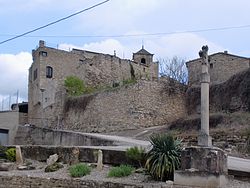Vallfogona de Riucorb: Difference between revisions
municat |
m r2.7.2+) (Robot: Adding ms:Vallfogona de Riucorb |
||
| Line 110: | Line 110: | ||
[[fr:Vallfogona de Riucorb]] |
[[fr:Vallfogona de Riucorb]] |
||
[[it:Vallfogona de Riucorb]] |
[[it:Vallfogona de Riucorb]] |
||
[[ms:Vallfogona de Riucorb]] |
|||
[[oc:Vallfogona de Riucorb]] |
[[oc:Vallfogona de Riucorb]] |
||
[[uz:Vallfogona de Riucorb]] |
[[uz:Vallfogona de Riucorb]] |
||
Revision as of 01:17, 16 January 2013
Vallfogona de Riucorb | |
|---|---|
 Vallfogona's castle and creu de terme (boundary cross) | |
| Country | |
| Community | |
| Province | Tarragona |
| Comarca | Conca de Barberà |
| Government | |
| • Mayor | Josep M. Bonastre Fabregat |
| Area | |
| • Total | 10.95 km2 (4.23 sq mi) |
| Elevation | 698 m (2,290 ft) |
| Population (2007) | |
| • Total | 158 |
| • Density | 14/km2 (37/sq mi) |
| Demonym | Vallfogoní |
| Time zone | UTC+1 (CET) |
| • Summer (DST) | UTC+2 (CEST) |
| Website | Official website |
Vallfogona de Riucorb (Catalan pronunciation: [ˌbaʎfuˈɣonə ðə riwˈkɔrp]) is a municipality in the comarca of the Conca de Barberà[1] in Catalonia, Spain. It is situated in the Comalats range in the north of the comarca, with the Cap de Cans rising to 759 m.
It is known for the medicinal mineral water that flows from a local spring, and for the priest and Baroque poet Francesc Vicent Garcia (1579-1623), "El Rector de Vallfogona." Garcia wrote mostly satirical verse, and was acquainted with notable authors of the time such as Lope de Vega. He ordered the construction of the chapel of Santa Bàrbara in 1617.
History

The first historical reference to Vallfogona records the founding of the parish in 1123 after its reconquest from the Moors, who had called it Vall d'Alfes. The town was a fief of the noble house of the Counts of Queralt. By 1150, the local lord, Gombau d'Oluja, had occupied the site of Vallfogona and had repopulated the area with Christian Catalans. He laid out the town, building a small castle and beginning construction on the town's Romanesque church, both of which still stand. On his death in 1191, Gombau ceded Vallfogona to the Knights Templar. When the Temple was suppressed in 1312, Vallfogona came under control of the Knights Hospitaller. In 1416 the Hospitallers reconstructed much of the church and castle.
Vallfogona's first tourist facility, the Fonda Dolores, opened in 1870 to serve visitors to the spring and its medicinal waters.
During the Spanish Civil War (1936–39), the hotels at the spa served as a hospital for wounded Republican soldiers. About 100 casualties were buried in a mass grave in the cemetery. Three men, all conservatives, were shot by leftist forces at the beginning of the conflict. Eleven soldiers from Vallfogona died in the fighting, all on the Republican side. The Francoist victors did not execute any Vallfogonins, but at least five of them were imprisoned and several had to flee to France. Vallfogona lost nearly 20% of its population.
Vallfogona de Riucorb became part of the Conca de Barberà in the comarcal reorganization of 1990: previously it had formed part of the Segarra.
On July 10, 2010, the newly restored Romanesque sculpture of Saint Peter "dels Vigues" was unveiled; it had been pulled down from the roof of Vallfogona's parish church by anarchists during the Spanish Civil War, and broken up. The restored statue is inside the church, and a copy was made and placed in the statue's original position on the roof above the front door.
Economy
Vallfogona depends economically on agriculture and tourism. It forms part of the officially recognized Costers del Segre wine region; other crops are olives, almonds, wheat, and barley. A spa-hotel complex was constructed in the early 20th century to take advantage of the spring's waters and attract visitors. Today Vallfogona has two hotels and a restaurant. Additionally, it has an attractive public swimming pool-bar open during the summer months, popular among the locals. The forests to the south and southeast of Vallfogona are mostly pine and oak.
Transportation
The village is linked to Guimerà and to Santa Coloma de Queralt by the L-241/T-241/T-224 road. It is served by a twice-daily bus service between Barcelona and Guimerà,[1] and a daily service between Vallfogona and Tàrrega.[2] A track connects Vallfogona with the naturist village of El Fonoll.
References
- Panareda Clopés, Josep Maria; Rios Calvet, Jaume; Rabella Vives, Josep Maria (1989). Guia de Catalunya, Barcelona:Caixa de Catalunya. ISBN 84-87135-01-3 (Spanish). ISBN 84-87135-02-1 (Catalan).
- ^ "Línies Interurbanes". Hispano Igualadina. Retrieved 2011-01-05.
- ^ "Bus Línia 313: Vallfogona de Riucorb - Tàrrega" (PDF). Àrea de Lleida: Autoritat Territorial de la Mobilitat. Retrieved 2012-06-06.
External links
- Official website c.
- Generalitat of Catalonia - data
- Statistical Institute of Catalonia - the municipality in figures


